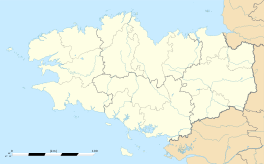Vannes
|
Vannes Gwened |
|||
|---|---|---|---|

Montage of Vannes
Top left: View of Ramparts Garden of Vannes and Gaillard Castle Museum; Top right: Saint Peters Cathedral; Middle left: Vieux lavoirs, old washing place; Center: Connetable Tower; Middle right: Intra Muros narrow street; Bottom left: Saint Paterne Church; Bottom right: Conleau Pier |
|||
|
|||
| Coordinates: 47°39′21″N 2°45′37″W / 47.6559°N 2.7603°WCoordinates: 47°39′21″N 2°45′37″W / 47.6559°N 2.7603°W | |||
| Country | France | ||
| Region | Brittany | ||
| Department | Morbihan | ||
| Arrondissement | Vannes | ||
| Canton | Vannes | ||
| Intercommunality | Pays de Vannes | ||
| Government | |||
| • Mayor (2011–2016) | David Robo | ||
| Area1 | 32.3 km2 (12.5 sq mi) | ||
| Population (2012)2 | 52,648 | ||
| • Density | 1,600/km2 (4,200/sq mi) | ||
| Time zone | CET (UTC+1) | ||
| • Summer (DST) | CEST (UTC+2) | ||
| INSEE/Postal code | 56260 / 56000 | ||
| Elevation | 0–56 m (0–184 ft) (avg. 22 m or 72 ft) |
||
|
1 French Land Register data, which excludes lakes, ponds, glaciers > 1 km² (0.386 sq mi or 247 acres) and river estuaries. 2Population without double counting: residents of multiple communes (e.g., students and military personnel) only counted once. |
|||
1 French Land Register data, which excludes lakes, ponds, glaciers > 1 km² (0.386 sq mi or 247 acres) and river estuaries.
Vannes (French pronunciation: [van]; Breton: Gwened) is a commune in the Morbihan department in Brittany in north-western France. It was founded over 2000 years ago.
Vannes is located on the Gulf of Morbihan at the mouth of two rivers, the Marle and the Vincin. It is around 100 kilometres (62 miles) northwest of Nantes and 450 km (280 mi) south west of Paris. Vannes is a market town and often linked to the sea.
The name Vannes comes from the Veneti, a seafaring Celtic people who lived in the south-western part of Armorica in Gaul before the Roman invasions. The region seems to have been involved in a cross channel trade for thousands of years, probably using hide boats and perhaps Ferriby Boats. Wheat that apparently was grown in the Middle East was part of this trade. At about 150 BC the evidence of trade (such as Gallo-Belgic coins) with the Thames estuary area of Great Britain dramatically increased.
The Veneti were defeated by Julius Caesar's fleet in 56 BC in front of Locmariaquer; many of the Veneti were then either slaughtered or sold into slavery. The Romans settled a town called Darioritum in a location previously belonging to the Veneti. From the 5th to the 7th century, the remaining Gauls were displaced or assimilated by waves of immigrant Britons fleeing the Saxon invasions of Britain. Under the Breton name Gwened (also derived from the Veneti), the town was the center of an independent principality or kingdom variously called Bro-Wened ("Vannes") or Bro-Ereg ("land of Gwereg"), the latter for a prominent member of its dynasty, which claimed descent from Caradog Strongarm. The diocese of Vannes was erected in the 5th century. The Council of Vannes was held there in 461. The realm annexed Cornouaille for a time in the early 6th century but was permanently joined with Domnonia under its king and saint Judicaël around 635.
...
Wikipedia




